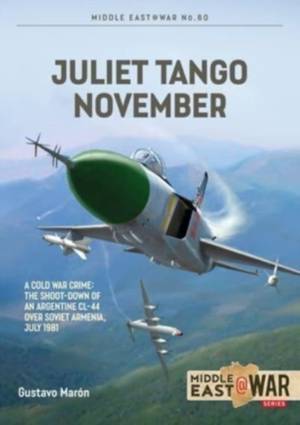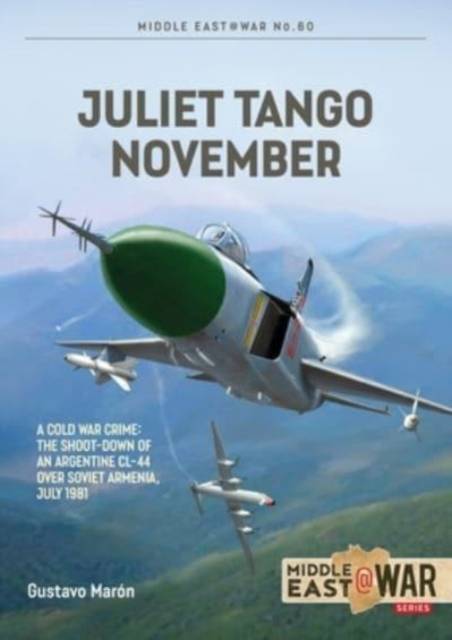
- Afhalen na 1 uur in een winkel met voorraad
- Gratis thuislevering in België vanaf € 30
- Ruim aanbod met 7 miljoen producten
- Afhalen na 1 uur in een winkel met voorraad
- Gratis thuislevering in België vanaf € 30
- Ruim aanbod met 7 miljoen producten
Zoeken
Juliet Tango November
A Cold War Crime: The Shoot-Down of an Argentine CL-44 Over Soviet Armenia, July 1981
Gustavo Marón
€ 27,95
+ 55 punten
Omschrijving
Gustavo Marón explores the downing of Argentine CL-44 over Soviet Armenia with color images and previously unseen photographs.
On 18 July 1981, a Canadair CL-44D Swingtail cargo aircraft of the Argentine company Transporte Aéreo Rioplatense mysteriously disappeared over the Soviet Republic of Armenia while on a flight from Iran via Turkey in the direction of Cyprus.
Four days later, on 22 July 1981, the Vremya TV broadcast in Moscow forwarded a report from the Soviet TASS news agency which stated that an aircraft of unidentified origin had entered Soviet territory in the vicinity of the Armenian city of Yerevan. According to the same release, the aircraft had ignored all calls from air traffic control and ended up crashing and burning after colliding with another Soviet aircraft.
With this cryptic information began one of the most impressive and least known stories of Argentine civil aviation: the shooting down of the freighter registered as LV-JTN by the Soviet Air Defense Force (V-PVO). The episode, heavily covered up by Moscow, was part of a much larger geopolitical scenario: the clandestine transport of US-made weapons and spare parts that was taking place between Tel Aviv and Tehran by virtue of a secret agreement between the Iranian and Israeli governments. All this at a time when the former was subjected to an arms embargo in revenge for the hostage-taking that occurred in 1979 at the US Embassy in Tehran.
The Islamic Republic of Iran, formed as a result of the Islamic Revolution that had broken out that same year, was an avowed enemy of Israel, whom it considered a mere Zionist regime that imposed itself in the occupation of Palestine. The Iranian religious leader Ruhollah Khomeini did not recognize the State of Israel, which he referred to simply as 'Little Satan'. However, the Iranians desperately needed supplies of US weapons as a few months earlier, on 22 September 1980, they had been invaded by Iraq. The Israelis saw the possibility of carrying out a sideline business and thus embarked on a clandestine supply operation.
The intelligence services of the Soviet Union soon became aware of the secret arms trafficking and decided to divert one of the involved aircraft into their airspace then force it to land in their territory with the aim of exposing the operation and all its protagonists. By interfering with radio communications and manipulating navigational aids, the KGB managed to divert the Argentine CL-44D from its route, with it ending up inside Soviet airspace. However, the Sukhoi Su-15TM interceptors of the V-PVO failed in their mission, and thus their ground control ordered the destruction of the target.
The Soviet conspiracy of silence began after discovering that its Air Defense Force had destroyed an Argentine-flagged civil plane, with an Argentine crew, which was flying empty. Juliet Tango November explores this incident in detail and is richly illustrated with color images and previously unseen photographs.
On 18 July 1981, a Canadair CL-44D Swingtail cargo aircraft of the Argentine company Transporte Aéreo Rioplatense mysteriously disappeared over the Soviet Republic of Armenia while on a flight from Iran via Turkey in the direction of Cyprus.
Four days later, on 22 July 1981, the Vremya TV broadcast in Moscow forwarded a report from the Soviet TASS news agency which stated that an aircraft of unidentified origin had entered Soviet territory in the vicinity of the Armenian city of Yerevan. According to the same release, the aircraft had ignored all calls from air traffic control and ended up crashing and burning after colliding with another Soviet aircraft.
With this cryptic information began one of the most impressive and least known stories of Argentine civil aviation: the shooting down of the freighter registered as LV-JTN by the Soviet Air Defense Force (V-PVO). The episode, heavily covered up by Moscow, was part of a much larger geopolitical scenario: the clandestine transport of US-made weapons and spare parts that was taking place between Tel Aviv and Tehran by virtue of a secret agreement between the Iranian and Israeli governments. All this at a time when the former was subjected to an arms embargo in revenge for the hostage-taking that occurred in 1979 at the US Embassy in Tehran.
The Islamic Republic of Iran, formed as a result of the Islamic Revolution that had broken out that same year, was an avowed enemy of Israel, whom it considered a mere Zionist regime that imposed itself in the occupation of Palestine. The Iranian religious leader Ruhollah Khomeini did not recognize the State of Israel, which he referred to simply as 'Little Satan'. However, the Iranians desperately needed supplies of US weapons as a few months earlier, on 22 September 1980, they had been invaded by Iraq. The Israelis saw the possibility of carrying out a sideline business and thus embarked on a clandestine supply operation.
The intelligence services of the Soviet Union soon became aware of the secret arms trafficking and decided to divert one of the involved aircraft into their airspace then force it to land in their territory with the aim of exposing the operation and all its protagonists. By interfering with radio communications and manipulating navigational aids, the KGB managed to divert the Argentine CL-44D from its route, with it ending up inside Soviet airspace. However, the Sukhoi Su-15TM interceptors of the V-PVO failed in their mission, and thus their ground control ordered the destruction of the target.
The Soviet conspiracy of silence began after discovering that its Air Defense Force had destroyed an Argentine-flagged civil plane, with an Argentine crew, which was flying empty. Juliet Tango November explores this incident in detail and is richly illustrated with color images and previously unseen photographs.
Specificaties
Betrokkenen
- Auteur(s):
- Uitgeverij:
Inhoud
- Aantal bladzijden:
- 76
- Taal:
- Engels
- Reeks:
Eigenschappen
- Productcode (EAN):
- 9781804513712
- Verschijningsdatum:
- 25/09/2023
- Uitvoering:
- Paperback
- Formaat:
- Trade paperback (VS)
- Afmetingen:
- 206 mm x 292 mm
- Gewicht:
- 272 g

Alleen bij Standaard Boekhandel
+ 55 punten op je klantenkaart van Standaard Boekhandel
Beoordelingen
We publiceren alleen reviews die voldoen aan de voorwaarden voor reviews. Bekijk onze voorwaarden voor reviews.








